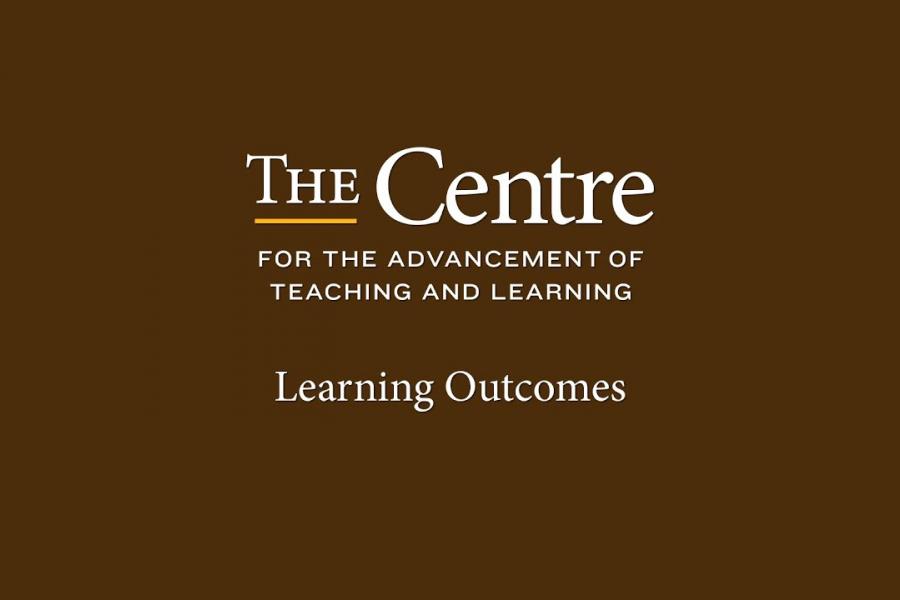Learning outcomes
By developing clearly written statements that describe what students will be able to do by the end of a course, post-secondary teachers can maintain a sharp focus on what is most important in their efforts to enrich the lives of their students.

Introduction
When your students walk out of the classroom at the end of the term, what will they be able to do, or perhaps do better? What will be the outcome of your efforts? For post-secondary teachers, these are important questions when designing and teaching a course.
It is widely believed that learning includes the development of new knowledge and skills. Such learning provides the foundation for action. In effect, learning is enriched by action, by doing. When students have the opportunity to go beyond the development of content acquisition and a conceptual understanding of a skill, when they apply or synthesize their understanding of skills and knowledge, they begin to retain a much deeper understanding of what they are learning.
A medical student can read about venipuncture, the act of drawing blood; they can even observe and comprehend the skill sets involved in the process, but until they have practiced drawing blood and have been provided with feedback and assessment in order to develop that skill, their learning is superficial at best. The same could be said of the skill sets required for academic writing, many of which require the ability to evaluate and synthesize information.
By developing clearly written statements that describe what students will be able to do by the end of a course, post-secondary teachers can maintain a sharp focus on what is most important in their efforts to enrich the lives of their students.
Interview
Resources
Developing Learning Outcomes (BYU Center for Teaching and Learning)
This page provides resources for using learning outcomes in your course planning in order to “give meaning and purpose to what students do in your course.”
Setting Learning Outcomes (Cornell University Center for Teaching Excellence)
The ‘What,’ ‘Why,’ and ‘How’ of learning outcomes.
Planning Your Course: A Decision Guide (Vanderbilt University’s Center for Teaching)
A simple and practical guide for developing course goals that are supported by learning activities and assessment.
Understanding by Design (Vanderbilt University’s Center for Teaching)
An overview of the book Understanding by Design and resources that assist in applying the book’s principles in course planning.
“Teaching is a means to an end. Having a clear goal helps us educators to focus our planning and guide purposeful action toward the intended results.” – Wiggins & McTighe (authors)
Identifying Program Outcomes (University of Waterloo’s Centre for Teaching Excellence)
A number of resources and guidelines are provided to support designing program outcomes.
Articulate Your Learning Objectives (Carnegie Mellon’s Eberly Centre for Teaching Excellence)
An excellent site that provides resources for creating your learning objectives that are connected to assessment and instructional activities
Further reading
Fink, L. D. (2003). Creating significant learning experiences: An integrated approach to designing college courses. San Francisco, Calif: Jossey-Bass.
Examples of outcomes
Examples based on Bloom’s Taxonomy and Anderson and Krathwohl’s Taxonomy.
| Level | The Student Should be Able To… |
|---|---|
| Remembering | Define iambic pentameter. State Newton’s laws of motion. Identify the major surrealist painters. |
| Understanding | Describe the trends in the graph in his or her own words. Summarize a passage from Socrates’ Apology. Properly translate into English passages from Voltaire’s Candide. |
| Applying | Describe an experiment to test the influence of light and light quality on the Hill reaction of photosynthesis. Scan a poem for metric foot and rhyme scheme. Use the Archimedes principle to determine volume of an irregularly shaped object. |
| Analyzing | List arguments for and against human cloning. Determine the variables to be controlled for an experiment. Discuss the rationale and efficacy of isolationism in the global economy. |
| Evaluating | Assess the validity of certain conclusions based on the data and statistical analysis. Critically analyze a novel with evidence to support a critique. Recommend stock investments based on recent company performance and projected value. |
| Creating | Write a short story in Hemingway’s style. Compose a logical argument on assisted suicide in opposition to his or her personal opinion. Construct a helium-neon laser. |
* Source: Nilson, L. (2010). Teaching at its best: A research-based resource for college instructors (3rd ed., Jossey-Bass higher and adult education series). San Francisco, CA: Jossey-Bass. (p. 23)
Student performance verbs to construct outcomes
| Concrete verbs such as “define”, “apply”, or “analyze” are more helpful for assessment than verbs such as “be exposed to”, “understand”, “know”, “be familiar with”. | |
|---|---|
| Cognitive and Skills Learning | Examples of Action Verbs |
| Remembering – to recall or remember facts without necessarily understanding them | articulate, define, indicate, name, order, recognize, relate, recall, reproduce, list, tell, describe, identify, show, label, tabulate, quote |
| Understanding – to understand and interpret learned information | classify, describe, discuss, explain, express, interpret, contrast, associate, differentiate, extend, translate, review, suggest, restate |
| Applying – to put ideas and concepts to work solving problems | apply, compute, give examples, investigate, experiment, solve, choose, predict, translate, employ operate, practice, schedule |
| Analyzing – to break information into its components to see interrelationships | analyze, appraise, calculate, categorize, compare, contrast, criticize, differentiate, distinguish, examine, investigate, interpret |
| Evaluating – to judge the value of information based on established criteria | appreciate, accept, attempt, challenge, defend, dispute, join, judge, praise, question, share, support |
| Creating – to use creativity to compose and design something original | arrange, assemble, collect, compose, construct, create, design, formulate, manage, organize, plan, prepare, propose, set up |
Adapted from: Bloom, B.S. (Ed.) (1956). Taxonomy of education objectives: The classification of educational goals: Handbook I, cognitive domain. New York, NY: Longmans, Green.

